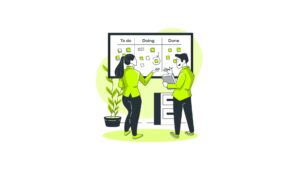Accept Cookies & Privacy Policy?
We use cookies to ensure that we give you the best experience on our website. If you continue to use this site we will assume that you accept and understand our Privacy Policy, and our Terms of Service.
Welcome back to our monthly poll session. This April, we’ve got our hands full with some intriguing poll scores from our teams, and it’s all about automation in the testing process.
The burning question of the month was: What percentage of the software testing process should be automated?
Here’s a breakdown of the results:
Less than 25%: The Old Schoolers
That’s the purists among us. Those who believe in the power of manual testing, the human touch, and the artistry of spotting bugs with their own two eyes. While there’s something nostalgic about manual testing, let’s face it, in today’s fast-paced tech landscape, relying solely on manual testing might leave you in the dust.
25% – 50%: The Balanced Brigade
These folks were all about finding that sweet spot between manual and automated testing. They understand the importance of automation in speeding up the testing process and catching those pesky bugs early on. But they also recognize the value of human intuition and creativity in uncovering those hard-to-find issues. Kudos to the balanced brigade for keeping it real!
51% – 75%: The Automation Advocates
Now we’re talking efficiency! The automation advocates know that time is money in the world of software development. By automating more than half of the testing process, they’re able to free up valuable human resources for more strategic tasks. Plus, with the right tools and frameworks in place, automation can significantly increase test coverage and reduce the risk of regression bugs. It’s a win-win!
More than 75%: The Winners
This winning group is on a mission to automate everything in sight, and who can blame them? With the advancements in AI and machine learning, it’s becoming increasingly feasible to automate the lion’s share of the testing process. From continuous integration and deployment pipelines to automated test suites that run like clockwork, these pioneers are leading the charge toward a future where manual testing is a thing of the past.
Speed and Efficiency: Automated tests can run much faster than their manual counterparts, allowing teams to uncover bugs and issues more quickly. This speed is crucial in today’s fast-paced development cycles.
Consistency: Testers are prone to limitations whether it’s due to fatigue, distractions, or overlooking certain scenarios. Automated tests, on the other hand, follow predefined scripts meticulously, ensuring consistent and reliable results every time.
Reusability: Once automated tests are created, they can be reused across different versions of the software, saving time and effort in the long run. This reusability also ensures that all aspects of the application are thoroughly tested across various releases.
Increased Test Coverage: With automation, it’s easier to achieve comprehensive test coverage by running tests across multiple platforms, devices, and configurations simultaneously. This broad coverage helps catch bugs that may only surface under specific conditions.
Regression Testing: One of the most significant advantages of automation is its ability to handle regression testing efficiently. By automating repetitive tests that verify existing functionalities, teams can focus their efforts on testing new features and improvements.
While automation offers numerous benefits, it’s essential to be aware of the challenges and considerations involved:
Initial Investment: Setting up automated testing frameworks and writing test scripts requires an upfront investment of time and resources. However, the long-term benefits often outweigh the initial costs.
Maintenance Overhead: Automated tests need regular maintenance to keep pace with changes in the application. As the software evolves, test scripts may require updates to reflect new features, UI changes, or functionality enhancements.
False Positives/Negatives: Automated tests may occasionally produce false positives (indicating a bug when there isn’t one) or false negatives (failing to detect an actual bug). It’s crucial to monitor and refine automated tests to minimize these occurrences.
Test Data Management: Automated tests rely on predefined test data, which must be carefully managed and maintained. Ensuring the accuracy and relevance of test data is essential for effective testing.
Test Selection Criteria: Not all tests are suitable for automation. It’s essential to assess each test case’s complexity, frequency of execution, and potential return on investment to determine whether automation is appropriate.
So, where do you fall on the spectrum? Are you a manual maven, a balanced believer, a mixed aficionado, or an all automation visionary?
By carefully weighing the benefits and challenges of automation and finding the right balance for the team and project, it can help harness its power to further streamline all testing processes and deliver higher quality software each time.
Until the next poll question may your codes be always bug-free!
Thought Frameworks is a U.S.-based leading QA and software testing organization that’s been in business since 2009, armed with the ultimate solutions for all your software’s QA testing challenges. Having headquarters both in California, USA, and a fully functional well equipped QA Test Lab in Bengaluru-India, that delivers premium QA and QC services endlessly across different Industry domains and niches. A CMMI Level 3 ISTQB Silver Partnered Company, our superhuman test team heroes have delivered numerous successful QA and QC projects for clients across the globe. Get powered by our deep dive bug-hunting process that helps your software in clocking release cycles on time while delivering excelling quality and functionality.

So picture this: You’re the air traffic controller of a chaotic airport where the planes (developers) don’t always listen, the passengers (stakeholders) want to change destinations mid-flight, and the weather (unforeseen blockers) is always unpredictable.

Imagine a world where testing is no longer a bottleneck. No more endless cycles of manual effort, no more missed defects due to human fatigue, and no more panic at the eleventh hour before a major ERP rollout.

Imagine a world where testing is no longer a bottleneck. No more endless cycles of manual effort, no more missed defects due to human fatigue, and no more panic at the eleventh hour before a major ERP rollout.

Let’s talk about GenAI and testing in 2025—the wild west of technology where machines are not just smart, but scary smart. GenAI (that’s Generative AI for the uninitiated) is running the show everywhere. It’s writing poetry, designing ads, debugging code, and probably plotting to take over my job as I write this blog.

Ah, 2024—you’ve been a year, haven’t you? For us at Thought Frameworks, this year wasn’t just about running the usual QA/QE playbook. Nope, we went full throttle into the future—tinkering, testing, and transforming everything from ERP systems to the ever-evolving world of SAP, GenAI, and security testing.

So, you’re deep in the ERP trenches and trying to figure out the best approach between NetSuite and Oracle EBS. You’re certainly not alone! We can help break down how these two ERP giants stack up when it comes to ensuring systems run like clockwork but without the overload.
Accept Cookies & Privacy Policy?
We use cookies to ensure that we give you the best experience on our website. If you continue to use this site we will assume that you accept and understand our Privacy Policy, and our Terms of Service.
| Cookie | Duration | Description |
|---|---|---|
| cookielawinfo-checkbox-analytics | 11 months | This cookie is set by GDPR Cookie Consent plugin. The cookie is used to store the user consent for the cookies in the category "Analytics". |
| cookielawinfo-checkbox-functional | 11 months | The cookie is set by GDPR cookie consent to record the user consent for the cookies in the category "Functional". |
| cookielawinfo-checkbox-necessary | 11 months | This cookie is set by GDPR Cookie Consent plugin. The cookies is used to store the user consent for the cookies in the category "Necessary". |
| cookielawinfo-checkbox-others | 11 months | This cookie is set by GDPR Cookie Consent plugin. The cookie is used to store the user consent for the cookies in the category "Other. |
| cookielawinfo-checkbox-performance | 11 months | This cookie is set by GDPR Cookie Consent plugin. The cookie is used to store the user consent for the cookies in the category "Performance". |
| viewed_cookie_policy | 11 months | The cookie is set by the GDPR Cookie Consent plugin and is used to store whether or not user has consented to the use of cookies. It does not store any personal data. |
Ready for a Quality Software?
Let’s Dig Deep Into Your Thought!